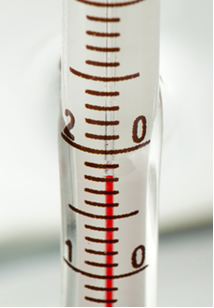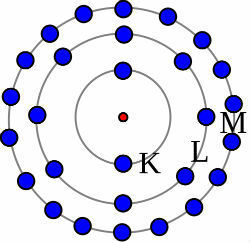Chemistry is a science that could not develop without considering the quantitative aspects. That's why countless experiments are performed and many measurements are made, such as mass, temperature, volume, etc.
Thus, it is of great importance that the person who takes these measurements knows what the significant figures are and what the rules for their use are.
Significant digits are all numbers that represent experimentally determined measurements, with only the last number a questionable digit.
For example, consider the temperature in degrees Celsius (°C), measured on the thermometer below:

Note that we are sure the temperature is between 1.8°C and 1.9°C. If we wished, it would be possible to estimate the hundredths of degrees. Considering that the column is closer to the 1.8°C mark, we could say the temperature is 1.82°C. However, the last digit is doubtful, it cannot be said that this is the correct temperature.
Thus, this measure (1.82 ºC) has 3 significant digits, the last digit (2) being uncertain.
All digits to the right of the questionable number must be disregarded.
Furthermore, zero will be considered only if it is part of the obtained measurement number, if it comes to the left of other digits, it is not considered significant, as in these cases they are used only to indicate the place decimal.
For example, assume the experimental measurement was 750.8. In this case, we have 4 significant digits, where the zero is counted because it is part of the number. If this value were expressed by scientific notations such as 0.0007508. 106, 0,007508. 105 and 75.08. 101, they would also all be 4 significant digits, because the leading zeros are mere occupants of decimal places.
Do not stop now... There's more after the advertising ;)
However, if this value were written as 7.5080. 102, now it would be different, because it would be understood that the value of the digit after the 8 is known, which is not the case with the previous number (750.8). So, in this case, there are 5 significant figures.
Significant digits are important because they indicate the precision of a measure, ie, the most accurate measurement is the one with the most significant digits. Remembering that the accuracy of a measure indicates how close the repeated measures are to each other.
The equipment used interferes in this case, as there are some that are more accurate than others.
Think, for example, of the weight of a sample measured on a tenth of g uncertainty balance (± 0.1 g), finding the value of 5.6 g. This same sample is then measured on an analytical balance whose uncertainty is a tenth of a milligram (±0.0001 g) and the value is 5.6137. The second measurement is more accurate as it has more significant figures.
In case of rounding of significant figures, we have the following rules:
- Greater than 5: One unit is increased.
Example: 23.4987 = 23.499
- Equal to 5: If the number to the left of 5 is even, it remains the same, but if it is odd, it increases by one.
Examples:
Par: 7.2845 = 7.284
Odd: 6.275 = 6.28
- Less than 5: Stays the same number.
Example: 2.1921 = 2.192.
By Jennifer Fogaça
Graduated in Chemistry


